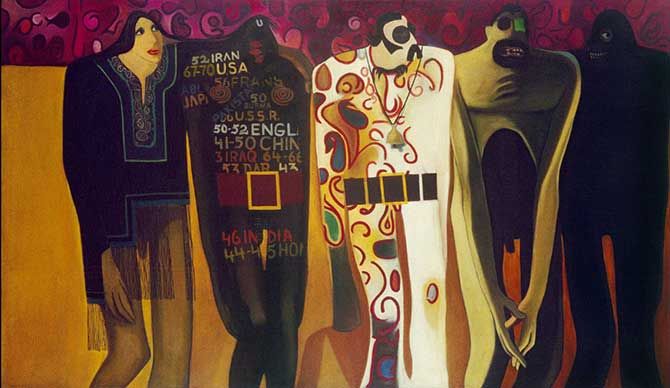 | « Back to article | Print this article |
This is the largest single-owner sale of Indian modern art, but it is for reasons other than this historicity that it will be remembered, says Kishore Singh.

The big buzz in the spring auctions of Indian art in New York this March is a single collector sale with 153 curated lots that measures the range and richness of modernism in the subcontinent.
Based entirely on Jane and Kito de Boer's methodically built up collection that began in 1992 and continues till date -- the couple was at India Art Fair in New Delhi earlier this year -- the Christie's auction of their works includes a live sale on the morning of March 18, as well as an online one from March 13 to 20.
If Christie's has put its muscle behind the de Boers' collection, it is because they have been well regarded as collectors.
A large part of their self-education in Indian modernism as well as collecting occurred during the seven years they were resident in New Delhi, but they continued to make frequent forays from Dubai and London, and collected Indian art overseas.
Only a small percentage of their collection will be auctioned.
For potential bidders, the excitement comes from the selection process that has been built into the lots -- from their keen eye to the curatorial process arrived between them and the auction house -- implying a tight editing of works on offer.
The quality is, therefore, assured and includes miniatures as well as instances of pre-modern art, besides, of course, representations of the Bengal School (of which they have been keen collectors), the Progressives (Souza, Gaitonde and Husain, in particular), as well as their own personal favourites that includes works by Rameshwar Broota.
In fact, this is possibly the largest auction outing for Broota, and punters will be watching to see how well he performs.
While record prices for Broota are on the anvil, fresh records for Indian art in general are expected.
This is the largest single-owner sale of Indian modern art, but it is for reasons other than this historicity that it will be remembered.
The auction comes at a time when interest in Indian art is once again perking, despite a sluggish economy.
More Indian artists have gone on view globally than at any time in recent years.
Within India too, the India Art Fair was a breath of fresh air with reports of handsome sales and a growing positivity.
A healthy interest could generate healthy sales.
That healthy interest comes from the quality of works on offer.
For some while, auctions dealing with Indian art have been struggling to find good properties in the absence of what was touted as a weak market sentiment.
This led to the chicken-and-egg situation where weak prices/works did no favour to potential collectors.
A sense of gloom had settled around the Indian art market despite an overall hardening of prices for quality works.
The de Boer sale then will help Indian art consolidate its position and prestige, and the proceeds could result in consigners improving the overall quality of works on offer in later editions.
Apart from the de Boer sale, Christie's is also offering 63 works at its auction of South Asian modern and contemporary art on the same day.
Sotheby's, meanwhile, has centred its March auction around artists whose works reflect their interest in tantric precepts ahead of the British Museum's April conference centred around tantra.
Such focused attention from recognised institutions will go a long way in establishing the reputation of Indian art not only among a slowly swelling base in India, but also among an international community outside the country that has so far remained outside its periphery.
The de Boers have been among a small handful of exceptions. That might well change.
Kishore Singh is a Delhi-based writer and art critic. These views are personal and do not reflect those of the organisation with which he is associated.